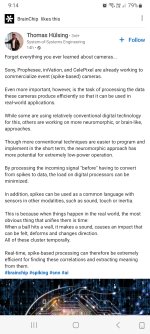Taproot
Regular
It's so great watching Tim Llewellyn frothing over Brainchip, his enthusiasm is infectious.Best advertising for us from NVISO..
NVISO and BrainChip make a #winningcombo! Get ready for a game-changing #neuromorphic demo at #CES2023.

#winningcombo #neuromorphic #ces2023 #9months #akida #optimised #neuro #sdk #automotive #drivermonitoring #interiorsensing #ultralowpower #ps5 #ar #vr #nocloud #battery #massive #power #cost #savings… | Timothy Llewellynn
NVISO and BrainChip make a #winningcombo! Get ready for a game-changing event-based fully digital #neuromorphic demo at #CES2023. It has only been #9months since we got our hands on the #akida silicon. Hence we are pretty excited to announce our partner BrainChip will be displaying our...www.linkedin.com
It has only been #9months since we got our hands on the first commercial #neuromorphic silicon. Hence we are pretty excited to announce our partner BrainChip will be displaying our #optimised #neuro #SDK designed to power next-generation #automotive #drivermonitoring and #interiorsensing solutions using standard CMOS RGB/NIR sensors capable to run at #ultralowpower.
NVISO Neuro SDK running on Akida allows somecrazy stuff. What makes this great
We can run models at over 1000 FPS at ultra-low power (models run faster with 1/3 clock speed of a GPU). Think #PS5 #AR #VR type experiences in your car. #nocloud #battery
Leverage 2/4-bit quantized models that use just KBs of RAM, resulting in #massive #power and #cost #savings during production. Put models into the #tiniestofplaces running at #ultralowpower.
🎖 Fully compatible with #existing #RGB #NIR sensors, allowing for the reuse of #proven #sensor #technology and the elimination of the need to qualify new sensors. Now new training datasets - completely reuse existing data investments.
Our #unique #holistic #approach to detecting #complex #emotions maps exceptionally well to Akida’s ability to handle simultaneous multiplexing of models, something that traditional cloud, mobile, or GPU systems struggle with. Get #more #bang for your $.
Read our full press release here: https://bit.ly/3GcTKPG
No time to read? (watch 3min video here): https://lnkd.in/eXynZ-Pu
Our software demo at CES will showcase #real #usescases of the power of our Neuro SDK when run on BrainChip Akida neuromorphic processor. If you are in the #automotive business of building #L3 automated cars Ola Kaellenius Benjamin Petz François Piednoel Magnus Östberg Frank Weber Peter Dr. Lehnert Mary Barra Valerie Brown Said Ben Shoham Oliver Hoffmann Neda Cvijetic Firas Lethaus Dr.-Ing. Mohsen Sefati James Kuffner and you don't have an end-to-end silicon to AI solution strategy - then you should haul yourself over to the Socionext US booth in Vehicle Tech and Advanced Mobility Zone in the Las Vegas Convention Center, North Hall, booth 10654 at #CES2023 and checkout the demo.
A huge thanks to the NVISO and BrainChip teams Miguel de Prado Luigi Bagnato Bogdan Lazar Abdelrahman Abubakr Colin Mason Anil Mankar Rob Telson Todd Vierra
Nikunj Kotecha Nandan Nayampally Richard Chevalier for all their hard work in getting this demo ready for CES 2023!
You can just tell that Akida is lighting up absolutely everything that he has been working so hard to achieve over the past 13 years.
He's so excited, that he barely seems to be able to contain himself
I can't help think that Luca Verre, ( Prophesee ), is feeling a little the same !
"Tim Llewellyn is President of Bonseyes AI Marketplace. Bonseyes is an open and expandable AI platform that intends to transform AI development from a cloud centric model, dominated by large internet companies, to an edge device centric model through a marketplace and an open AI platform. Tim Llewellyn is also CEO and co-founder of Nviso, a company that provides artificial intelligence solutions."
"Tim Llewellyn started nViso October 2009"
"Tim Llewellyn is CEO and Co-founder of nViso SA. Tim has 10 years’ experience in high-tech startups and is pioneering a truly scalable emotion recognition platform to help capture and analyze the emotional response and visual attention of consumers on a scale and level of detail not previously possible. Tim received his B.E. and M.E. (Hons) degrees in Electrical Engineering from the University of Canterbury, New Zealand in 1999 and 2001. Tim was a speaker at the ESOMAR 3D Digital Dimensions 2011 conference in Miami. Prior to founding nViso, Tim worked on ultralow power wearable devices as part of the Swatch Group. In Swatch, Tim helped build the first ultra-low power Smart Watches together with Microsoft, which turned out well ahead of its time."









